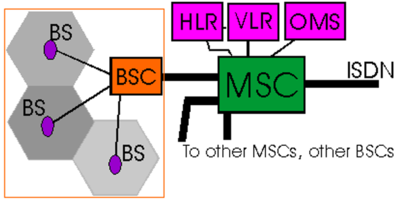Advanced Mobile Phone Service (AMPS)
Advanced Mobile Phone Service (AMPS) is a first-generation analog, circuit-switched cellular phone network. Originally operating in the 800 MHz band, service was later expanded to include transmissions in the 1900 MHz band, the VHF range in which most wireless carriers operate. Because AMPS uses analog signals, it cannot transmit digital signals and cannot transport data packets without assistance from newer technologies such as TDMA and CDMA.[1]
The Origin of Advanced Mobile Phone Service (AMPS)[2]
Advanced Mobile Phone Service, Inc. was a subsidiary of AT&T prior to the Bell System Divestiture. Abbreviated AMPS, the company was created in 1978 to build and operate the new Advanced Mobile Phone System, also abbreviated AMPS. AMPS was developed by Bell Labs to replace older, severely limited radiophone services, such as IMTS. AMPS was one of the first modern cellular phone systems, which remained in operation until 2008. Service started in Chicago on October 13, 1983, and in the Washington, D.C., area December 1983. After divestiture, AMPS was divided among the 7 newly created Regional Holding Companies, now known as RBOCs:
- NYNEX Mobile Communications
- Bell Atlantic Mobile Systems
- Ameritech Mobile Communications
- BellSouth Mobility
- PacTel Mobile Access
- Southwestern Bell Mobile Systems
- U S West NewVector
How AMPS Works[3]
AMPS uses frequencies in the 800-MHz to 900-MHz range of the radio spectrum. It modulates a 3-kHz voice channel onto 30-kHz FM carrier signals using Frequency Division Multiple Access (FDMA) to create a series of 30-kHz channels. Separate channels are used for base station to mobile transmission (forward channels) and mobile station to base transmission (backward channels). The resulting allocation of bandwidth for each channel results in a maximum of approximately 800 simultaneous phone conversations per operator. Because the population of most cities would suggest that 800 simultaneous phone conversations is far from enough, the idea was developed to partition the coverage of cities into a number of small areas called “cells.” Each base station uses a limited-power transmitter with a directional antenna to provide coverage for a small geographical cell (from which the term “cellular communication” arose). A typical cell ranges from .5 kilometer to 20 kilometers in size, depending on whether the coverage is in a densely populated urban area or a sparsely populated rural one. Mobile users’ phones also have limited transmission power, meaning that communication is usually limited to the immediate cell the user is in. As a user moves from one cell to another, the signal is smoothly picked up from the new cell. Adjacent cells use different frequencies, which prevents interference. Handheld AMPS cellular phones have power levels generally under 0.6 watts with a range of about 5 miles from the base station, while power levels in vehicle-mounted phones reach up to 3 watts with a range of 15 miles. Base stations themselves generally have power levels up to about 1 kilowatt. Because of the need for data transmission and security (encryption), digital cellular phone services are increasing in popularity.
Advanced Mobile Phone System (AMPS) Network Layout (see figure below)[4]
The D-AMPS 800/1900 system architecture is similar to most other cellular system architectures (e.g. GSM network architecture). It contains a Switching System, an Operation and Support System, base stations and mobile station.
- The Switching System contains five main functional entities:
- The Mobile Switching Center (MSC) performs the telephony switching functions for the network. It controls calls to and from other telephone and data communications networks such as Public Switched Telephone Networks (PSTN), Integrated Services Digital Networks (ISDN), Public Land Mobile Networks (PLMN) and Public Data Networks.
- The Visitor Location Register (VLR) database contains all temporary subscriber information needed by the MSC to serve visiting subscribers who are temporarily in the area of the MSC.
- The Home Location Register (HLR) database stores and manages user subscriptions. It contains all permanent subscriber information including the their service profile, location information and activity status.
- The Authentication Center (AC) supports authentication and encryption functionality. It verifies the user’s identity (by authentication) and ensures the confidentiality of each call (by encryption) . This protects network operators against fraud.
- The Message Center (MC) supports messaging services.
- The Base Station is the radio equipment needed to serve each cell in the network. One base station site may serve more than one cell.
- The Operation and Support System supports operation and maintenance activities in the network to allow for reliable and cost-efficient operation.
- The Mobile station

source: Wireless Communication
References
- ↑ What is Advanced mobile phone service (AMPS)? Expert Glossary
- ↑ The Origin of Advanced Mobile Phone Service (AMPS) Wikipedia
- ↑ How AMPS Works The Network Encyclopedia
- ↑ Advanced Mobile Phone System (AMPS) Network Layout [^http://www.wirelesscommunication.nl/reference/chaptr01/telephon/amps.htm%7CWireless Communication]
Further Reading
- Building an Advanced Mobile Phone Service (AMPS) Base Station Mike Szczys
- Retrotechtacular: Ma Bell's Advanced Mobile Phone Service (AMPS) Kristina Panos
- Advanced Mobile Phone Service (AMPS): An Overview Vijaya Chandran Ramasami
